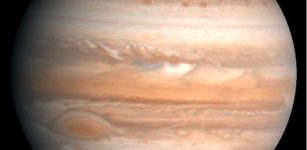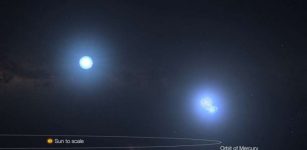Solution To Cosmic Mystery: The Eccentric Orbits Of Trans-Neptunian Objects
Eddie Gonzales Jr. – MessageToEagle.com – New evidence suggests that billions of years ago, a star passed close to our solar system, deflecting thousands of smaller celestial bodies in the outer solar system into highly inclined trajectories around the sun.
The perturber star approaches from the bottom right. The sequence shows the typical appearance of two spiral arms, the loss of matter that becomes unbound and the capture of some material by the perturber star. The time is given in years relative to the time of periastron passage. For the first four snapshots, the size of the real area is kept constant; the last two plots show a zoom-out. The colours indicate the velocities of the test particles relative to the Sun. Source
It is possible that some of them were captured by the planets Jupiter and Saturn as moons.
These findings come from a team of astrophysicists from Forschungszentrum Jülich and Leiden University in the Netherlands. They were published in two studies in the journals Nature Astronomy and The Astrophysical Journal Letters.
When we think of our solar system, we usually assume that it ends at the outermost known planet, Neptune. “However, several thousand celestial bodies are known to move beyond the orbit of Neptune,” explains Susanne Pfalzner, astrophysicist at Forschungszentrum Jülich.
It is even suspected that there are tens of thousands of objects with a diameter of more than 100 kilometers. “Surprisingly, many of these so-called trans-Neptunian objects move on eccentric orbits that are inclined relative to the common orbital plane of the planets in the solar system.”
Together with her Jülich colleague Amith Govind and Simon Portegies Zwart from Leiden University, Susanne Pfalzner has used more than 3,000 computer simulations to investigate a possible cause of the unusual orbits: could another star have caused the strange orbits of trans-Neptunian objects?
The three astrophysicists found that a distinctive, close flyby of another star can explain the inclined and eccentric orbits of the known trans-Neptunian celestial bodies. “Even the orbits of very distant objects can be deduced, such as that of the dwarf planet Sedna in the outermost reaches of the solar system, which was discovered in 2003.
“And also objects that move in orbits almost perpendicular to the planetary orbits,” says Susanne Pfalzner. Such a flyby can even explain the orbits of 2008 KV42 and 2011 KT19—the two celestial bodies that move in the opposite direction to the planets.
The dwarf planet Pluto orbits the Sun beyond Neptune’s orbit. Image credit: NASA / JPL
“The best match for today’s outer solar system that we found with our simulations is a star that was slightly lighter than our sun—about 0.8 solar masses,” explains Pfalzner’s colleague Amith Govind. “This star flew past our sun at a distance of around 16.5 billion kilometers. That’s about 110 times the distance between Earth and the sun, a little less than four times the distance of the outermost planet Neptune.”
However, the scientists’ most surprising realization was that the flyby of an alien star billions of years ago could also provide a natural explanation for phenomena closer to home. Susanne Pfalzner and her colleagues found that in their simulations, some trans-Neptunian objects were hurled into our solar system—into the region of the outer giant planets Jupiter, Saturn, Uranus and Neptune.
“Some of these objects could have been captured by the giant planets as moons,” says Simon Portegies Zwart from Leiden University, in a press release. “This would explain why the outer planets of our solar system have two different types of moons.”
In contrast to the regular moons, which orbit close to the planet on circular orbits, the irregular moons orbit the planet at a greater distance on inclined, elongated orbits. Until now, there was no explanation for this phenomenon.
“The beauty of this model lies in its simplicity,” says Pfalzner. “It answers several open questions about our solar system with just a single cause.”
Papers:
Susanne Pfalzner et al, Trajectory of the stellar flyby that shaped the outer Solar System, Nature Astronomy (2024). DOI: 10.1038/s41550-024-02349-x
Susanne Pfalzner et al, Irregular Moons Possibly Injected from the Outer Solar System by a Stellar Flyby, The Astrophysical Journal Letters (2024). DOI: 10.3847/2041-8213/ad63a6
Written by Eddie Gonzales Jr. – MessageToEagle.com Staff Writer












